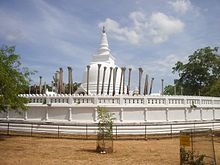Thuparamaya
Thuparamaya ( Sinhala ථූපාරාමය ) is the oldest Buddhist temple in Sri Lanka . The stupa (Sinhala dagoba ) is located in the sacred precinct of the Mahamevnāwa Gardens (මහමෙවුනා උයන) in Anuradhapura . Its origins go back to the reign of King Devanampiya Tissa (247–207 BC). The stupa was formally included in the List of Archaeological Protected Monuments in Sri Lanka as an "Archaeological Site" by the Government of Sri Lanka .
history

Mahinda Thera, an envoy of King Ashoka , brought the Theravada - Buddhism along with the veneration of form Chaitya to Sri Lanka. At his pleas through built King Tissa Devanampiya the stupa Thuparamaya in which he the right clavicle of Buddha was kept. Thuparamaya is now the oldest stupa and the first monument whose construction is attested in writing. The name Thuparamaya is made up of the components stupa and aramaya , a name for the residential buildings of monks.
According to the Palumekichchawa inscription , the Madamanaka Reservoir (Palumekichchawa Wewa) was built by Upala Vibajaka at a cost of 5000 Kahavanu and given to the bhikkus who lived in the Thuparama Temple. The inscription also states that the harvest from the rice fields around the reservoir should be given to the bhikkus. The inscription is the oldest carved stone inscription in which the name Thuparama appears. It has been dated to the reign of King Gajabahu I of Anuradhapura (114-136 AD).
shape
Thuparamaya Dagoba has the shape of a bell . This structure was destroyed several times. During the reign of Aggabodhi II of Anuradhapura, it was completely destroyed and rebuilt by the king. The current structure was built in 1842. Today the building has a diameter of 18 m at the base and a height of 3.45 m. The surrounding complex is paved with granite stones and a double row of stone pillars surrounds the stupa. In an earlier phase there was probably a Vatadage (colonnade), which surrounded the Thuparamaya.
Individual evidence
- ↑ CA Gunawardena: Encyclopedia of Sri Lanka . Sterlin Publishers Pvt. Ltd., New Delhi-110020, 2003, ISBN 81-207-2536-0 , p. 290.
- ↑ ශ්රී ලංකාවේ පුරාවිද්යා ආරක්ෂිත ස්මාරක ලැයිස්තුව Archaeological Sites (Map) . Department of Archeology. Retrieved September 20, 2017.
- ↑ W. Vivian De Thabrew: Monuments and Temples of Orthodox Buddhism in India and Sri Lanka . AuthorHouse, 2013, ISBN 9781481795517 , p. 59: "Accordingly the right collar-bone of the Buddha was received with great veneration and pomp and enshrined"
- ^ Royal Asiatic Society of Sri Lanka, Royal Asiatic Society of Great Britain and Ireland. Sri Lanka Branch: Journal of the Royal Asiatic Society of Sri Lanka, Volume 33 . Royal Asiatic Society of Sri Lanka, 1990, p. 10: "... to the building of the Thuparamaya, the first stupa to be built in Lanka to enshrine the right collar-bone relics of the Great Teacher (Buddha)."
- ^ To protect oldest stone inscription Irrigation Dept constructs wall . In: Ceylon Today , Ceylon Newspapers (Private) Limited. 11th September 2017.
- ↑ සෙල්ලිපියට කොන්ක්රීට් දැමූ පින්වතුන්! (Sinhala) In: Deshaya , Wijeya Newspapers , September 16, 2017.
Web links
- Discover Sri Lanka. Information & pictures
- Photos by Thuparamaya
- lankalibrary.com , Rohan Hettiarachchi
Coordinates: 8 ° 21 ′ 19 ″ N , 80 ° 23 ′ 46 ″ E

